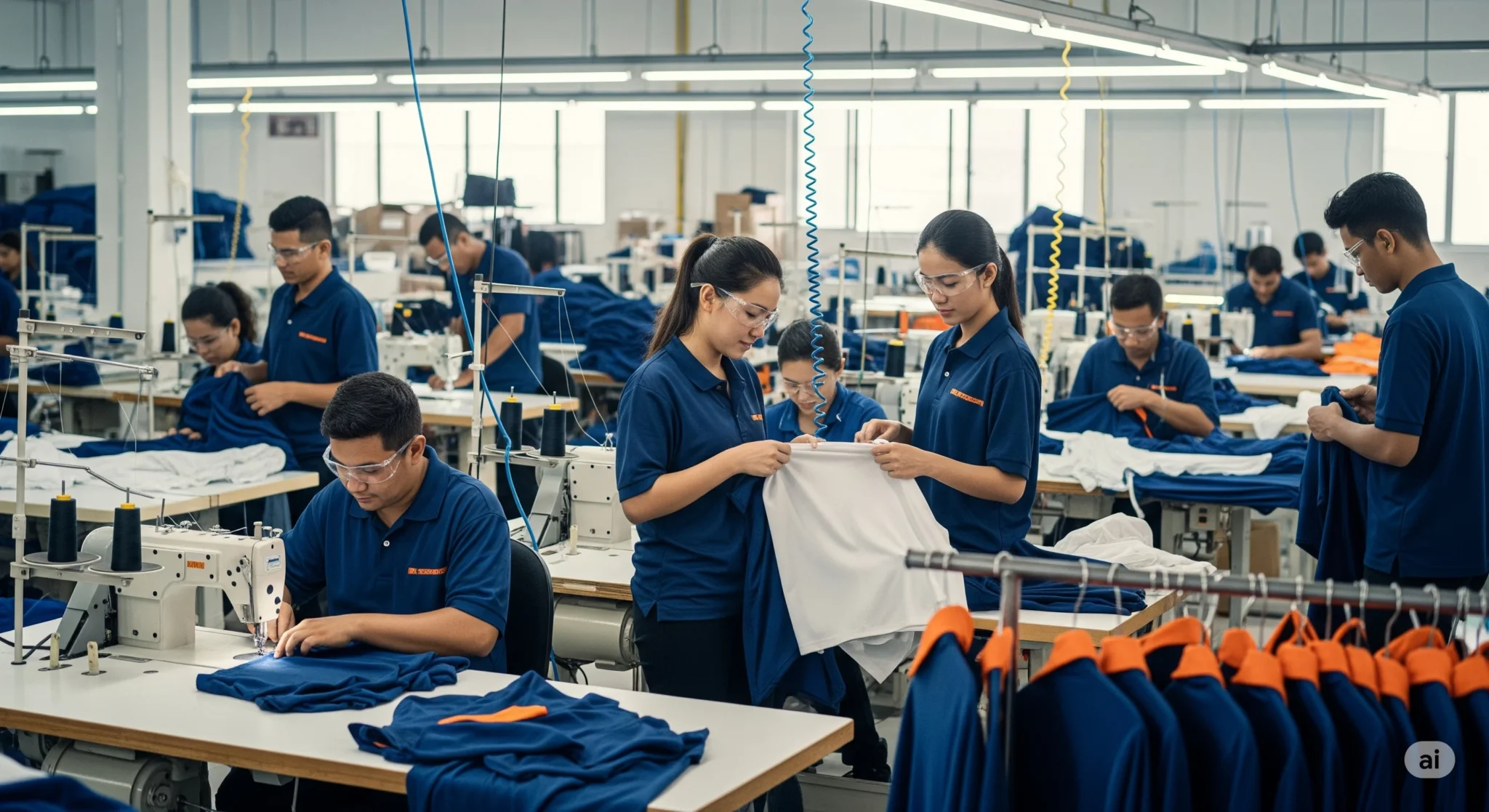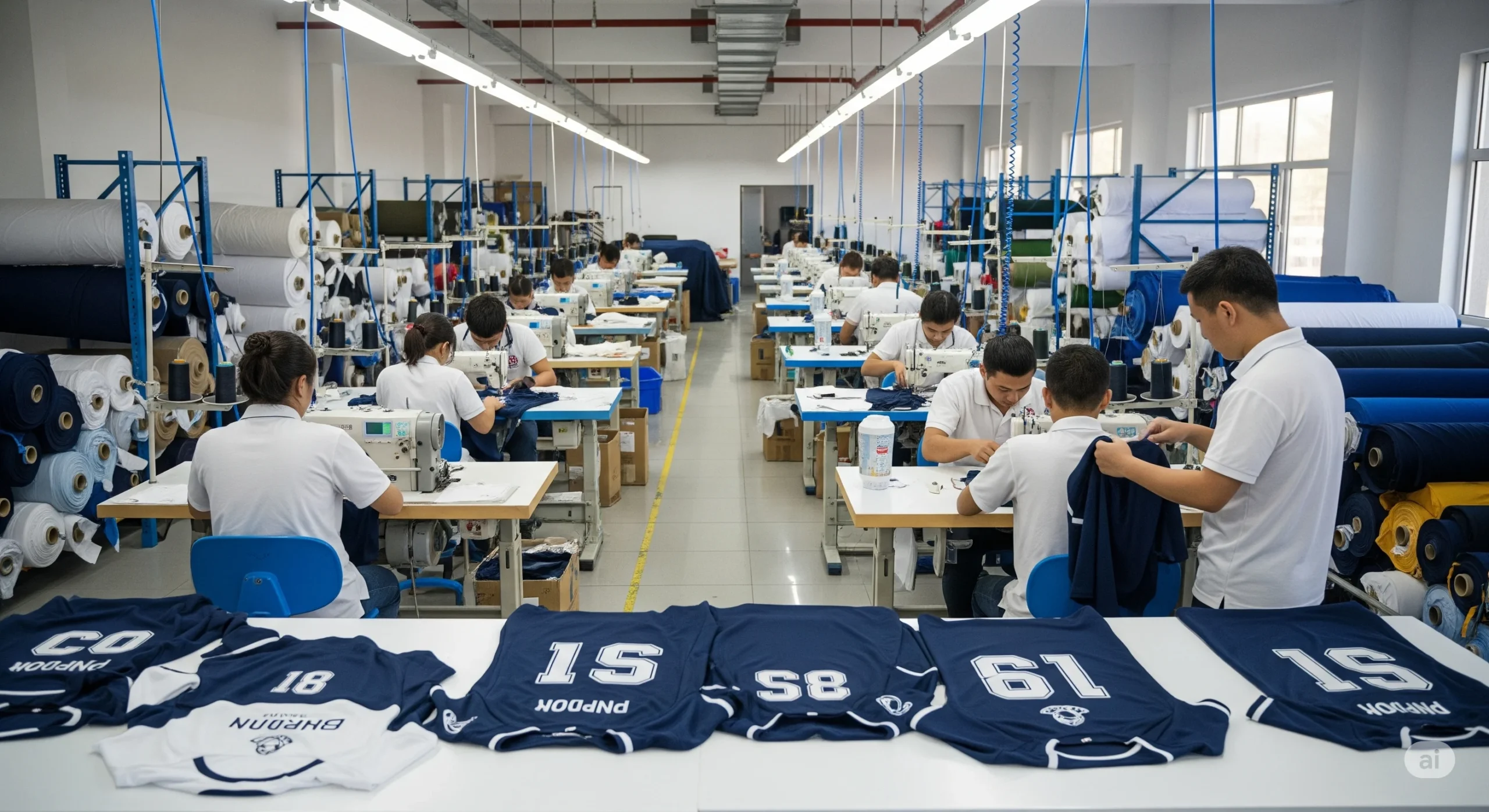Blog
-
Offered Impex
Custom Team Uniforms Manufacturer: A Step-by-Step Guide

Mins To Read
Table of Contents
ToggleCustom Team Uniforms Manufacturer: A Step-by-Step Guide
Choosing the right custom team uniforms manufacturer is a crucial step in outfitting your team for success. Dealing directly with a factory, rather than a reseller, can offer significant advantages in terms of customization, cost, and communication. This comprehensive guide will walk you through the essential steps to ensure a smooth ordering process and high-quality results for your custom team apparel.
Why Order from a Factory Instead of a Reseller?
Opting for a direct custom team uniforms manufacturer like a dedicated teamwear factory offers several key benefits over purchasing through a reseller or intermediary:
- Cost Savings: By eliminating the middleman, you can often secure better pricing. Resellers add markups to the factory price, so going direct can lead to significant savings, especially for bulk orders.
- Greater Customization Control: Working directly with the manufacturing source means you have more say in the design, materials, and specific features of your uniforms. You can discuss intricate details and possibilities that might be limited with a reseller.
- Direct Communication: Clear and direct communication with the production team can reduce misunderstandings about designs, timelines, and quality expectations. This ensures your vision is accurately translated into the final product.
- Faster Turnaround Potential: While not always guaranteed, direct engagement can sometimes lead to quicker production and delivery times as there are fewer parties involved in the communication and decision-making chain.
- Transparency: You gain better insight into the production process, material sourcing, and quality control measures of the sports uniform supplier.
Step 1: Define Your Team’s Requirements
Before you even start searching for a manufacturer, it’s vital to have a clear understanding of your team’s needs. This initial preparation will streamline the entire process.
- Sport Specifics: Different sports have different uniform requirements. For example, custom basketball uniforms will have different cuts and material needs than soccer or baseball uniforms.
- Quantity: How many uniforms do you need? Include player kits, coaching staff apparel, and any extras for new members or replacements.
- Budget: Establish a realistic budget. This will help filter manufacturers and customization options.
- Material Preferences: Consider factors like breathability, durability, moisture-wicking properties, and fabric weight. Research common materials used for your specific sport.
- Required Items: List everything you need – jerseys, shorts, pants, socks, warm-up gear, etc.
Step 2: Choose Customization Options
This is where your team’s identity comes to life. A good custom team uniforms manufacturer will offer a range of options:
- Decoration Methods:
- Sublimation: Dyes are infused directly into the fabric, allowing for complex, all-over designs that won’t crack, peel, or fade. Ideal for vibrant and intricate artwork.
- Screen Printing: Ink is applied to the fabric surface. Cost-effective for simpler designs and larger quantities.
- Embroidery: Stitching creates a textured, high-quality look, often used for logos and crests.
- Heat Transfer (Vinyl/Digital): Designs are printed on special paper and then heat-pressed onto the garment. Good for individual names and numbers.
- Logos and Graphics: Placement, size, and colors of team logos, sponsor logos, and any other graphical elements.
- Names and Numbers: Font style, size, and color for player names and numbers.
- Trim and Accents: Piping, braids, or contrasting color panels that can enhance the uniform’s design.
At Offered Impex, we provide a wide array of customization techniques to perfectly match your vision for your custom team apparel.
Step 3: Get the Right Size Chart
Incorrect sizing is one of the most common issues when ordering custom uniforms. Always request a detailed size chart from your chosen manufacturer before placing an order.
- Manufacturer-Specific Charts: Sizes can vary significantly between manufacturers. Do not assume a “Large” from one supplier is the same as another.
- Measurement Guidelines: Ensure the chart provides clear instructions on how to take measurements (e.g., chest, waist, inseam).
- Consider Player Build: Some players might need athletic fit while others prefer a looser cut. Discuss these options if available.
- Sample Sizing Kit: If possible, ask if the factory can provide a sizing kit with samples of different sizes, especially for large or high-stakes orders.
Step 4: Check Factory Portfolio and Experience
It’s crucial to verify the credibility and capability of your potential sports uniform supplier.
- Review Their Portfolio: Look for examples of uniforms they have produced for other teams, particularly in your sport. Assess the quality of design, materials, and construction.
- Years in Business: While not the only factor, a longer history can indicate stability and experience.
- Client Testimonials and Reviews: Search for online reviews or ask for references. What do other customers say about their quality, service, and reliability?
- Specialization: Does the factory specialize in the type of uniforms you need? A specialist might offer better insights and quality for your specific sport.
Step 5: Ask About Sample Orders
Never commit to a full production run without first seeing and approving a sample. This is a critical quality control step.
- Pre-Production Sample: Request a fully customized sample featuring your design, chosen materials, and customization techniques.
- Cost of Samples: Factories usually charge for samples, but this cost is often credited towards your full order if you proceed. At Offered Impex, you can easily order samples to ensure you’re satisfied with the quality before committing to a larger purchase.
- Review Thoroughly: Check the sample for design accuracy, color correctness, material quality, stitching, sizing, and overall feel.
Step 6: Submit Your Design Files
Providing your designs in the correct format is essential for accurate reproduction.
- Vector Files Preferred: Most manufacturers prefer vector files (e.g., .AI, .EPS, .PDF) for logos and artwork. Vector graphics can be scaled to any size without losing quality. For more information on vector graphics, you can visit resources like Adobe’s overview on vector graphics.
- High-Resolution Raster Files: If vector isn’t possible, provide high-resolution raster files (e.g., .PSD, .TIFF, .PNG) – typically 300 DPI at the intended print size.
- Color Codes: Specify color codes (e.g., Pantone Matching System – PMS) to ensure color accuracy.
- Mock-ups: Provide detailed mock-ups showing the placement of all design elements, names, and numbers.
Step 7: Confirm MOQ and Production Time
Understand the factory’s operational parameters before finalizing your order.
- Minimum Order Quantity (MOQ): Most manufacturers have an MOQ, which is the smallest number of units they will produce for a custom order. Ensure your required quantity meets this.
- Production Time (Lead Time): This is the time it takes from order confirmation (and sample approval) to when the uniforms are ready for shipping. This can vary based on order complexity, quantity, and the factory’s current workload.
- Peak Seasons: Be aware that production times might be longer during peak sports seasons. Plan accordingly.
Step 8: Understand Payment Terms
Clear payment terms prevent misunderstandings and ensure a smooth transaction.
- Deposit: Most factories require an upfront deposit (e.g., 50%) to start production. This covers material costs and secures your production slot.
- Balance Payment: The remaining balance is typically due before shipping or upon completion of the order.
- Payment Methods: Confirm accepted payment methods (e.g., bank transfer, credit card, PayPal). Be aware of any transaction fees.
- Written Agreement: Always get payment terms in writing within your formal order confirmation or contract.
Step 9: Shipping and Delivery Information
Logistics are a key part of receiving your custom team apparel on time.
- Shipping Options: Discuss available shipping methods (e.g., air freight, sea freight, courier services like DHL/FedEx). Air freight is faster but more expensive; sea freight is slower but more cost-effective for bulk orders.
- Shipping Costs: Get a clear quote for shipping costs. This may or may not include insurance.
- Import Duties and Taxes: If ordering from an international teamwear factory, be aware of potential import duties, taxes, and customs clearance fees in your country. Reputable sources like the International Trade Administration can offer general guidance, but specific costs will depend on your country’s regulations.
- Tracking Information: Ensure the factory will provide tracking information once the order is dispatched.
- Delivery Address: Double-check the accuracy of the delivery address.
Step 10: After-Sales Support
A reputable manufacturer stands by its products. Inquire about their after-sales service.
- Warranty/Guarantee: Ask if they offer any warranty against manufacturing defects (e.g., stitching issues, printing errors).
- Return/Remake Policy: Understand their policy for addressing issues like incorrect orders, damaged goods, or items that don’t match the approved sample.
- Re-Order Process: If you need to order additional uniforms in the future (e.g., for new players), how easy is it to place a re-order with consistent quality and design? Offered Impex keeps your designs on file, simplifying the re-ordering process.
Common Mistakes to Avoid When Ordering
Navigating the custom uniform process can be tricky. Here are some common pitfalls to watch out for:
- Unclear Design Specifications: Vague instructions or low-quality artwork can lead to disappointing results.
- Skipping Sample Approval: This is a huge risk. Always approve a physical sample.
- Incorrect Sizing: Not using the manufacturer’s specific size chart or failing to account for player preferences.
- Ignoring MOQs and Lead Times: Misunderstanding these can lead to delays or inability to place an order.
- Not Clarifying All Costs: Ensure all costs (unit price, setup fees, shipping, taxes) are clearly itemized.
- Poor Communication: Lack of timely or clear communication with the factory can cause errors.
Final Checklist Before You Confirm the Order
Before giving the final go-ahead, run through this quick checklist:
- Are all design details (colors, logos, names, numbers, placement) confirmed and accurate on the final mock-up/proof?
- Has a physical sample been approved?
- Are all sizes confirmed against the manufacturer’s chart?
- Is the total quantity of each item and size correct?
- Are the material specifications as agreed?
- Is the price per unit and total cost clear and all-inclusive (or are extra costs itemized)?
- Are the payment terms understood and agreed upon?
- Is the production lead time acceptable and confirmed?
- Are shipping details and costs finalized?
FAQs: Ordering Custom Team Uniforms from a Factory
1. How long does it typically take to get custom uniforms made by a factory?
Production time can vary from 3 to 8 weeks, depending on the complexity of the design, quantity ordered, customization techniques used, and the factory’s current production schedule. Always confirm the lead time with your specific custom team uniforms manufacturer.
2. What is the advantage of sublimation for custom sports apparel?
Sublimation allows for full-color, vibrant designs that are embedded directly into the fabric. This means the design won’t crack, peel, or fade over time, and it doesn’t add extra weight or affect the breathability of the garment, making it ideal for athletic wear.
3. Can I supply my own fabric to a teamwear factory?
This is generally uncommon and depends on the factory’s policies. Most manufacturers have established supply chains for fabrics that are tested and proven for their production processes. It’s best to discuss this directly, but be prepared for them to prefer using their own sourced materials for quality control.
4. What if there are defects in my delivered uniforms?
A reputable factory should have a policy for addressing manufacturing defects. This usually involves providing photographic evidence of the defect. Depending on the issue and their policy, they might offer a remake of the defective items, a discount, or a credit. Clarify this before ordering.
5. How do I ensure the colors of my uniforms are accurate?
The best way to ensure color accuracy is to provide Pantone Matching System (PMS) color codes for your designs. Computer screen colors can vary, so PMS codes provide a standardized reference for the factory to match. Always check colors on your physical sample.
Newsletter
Subscribe my newsletter to get the latest posts delivered right to your email.
